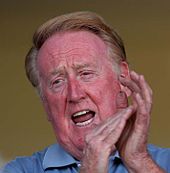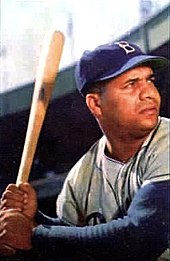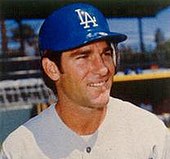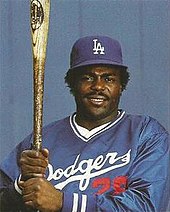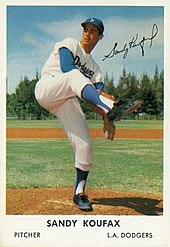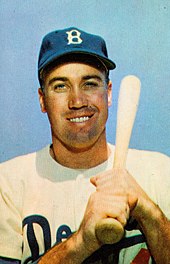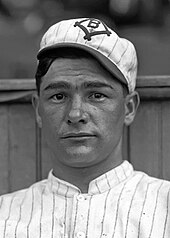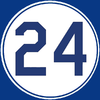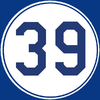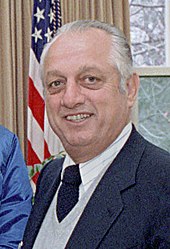Dodgers
After 68 seasons in Brooklyn, Dodgers owner and president Walter O'Malley moved the franchise to Los Angeles before the 1958 season. The team played their first four seasons at the Los Angeles Memorial Coliseum before moving to their current home of Dodger Stadium in 1962. The Dodgers found immediate success in Los Angeles, winning the 1959 World Series. Success continued into the 1960s; their ace pitchers Sandy Koufax and Don Drysdale were the cornerstones of titles in 1963 and 1965. In 1981, rookie Mexican phenom pitcher Fernando Valenzuela became a sensation and led the team to a championship; he is the only player to win the Cy Young and Rookie of the Year awards in the same season. The Dodgers were once again victorious in 1988, upsetting their heavily favored opponent in each series and becoming the only franchise to win multiple titles in the 1980s. Next came a 32-year championship drought, despite 12 postseason appearances in a 17-year span and eight consecutive division titles from 2013 to 2020. It was broken when the Dodgers won the 2020 World Series. The Dodgers signed global sensation Shohei Ohtani in 2024, who set league and franchise records with the team en route to their eighth World Series title that season.
One of the most successful and storied franchises in MLB, the Dodgers have won eight World Series championships and a record 25 National League pennants. Eleven NL MVP award winners have played for the Dodgers, winning a total of 14. Eight Cy Young Award winners have pitched for the club, winning a total of 12—by far the most of any Major League franchise. The Dodgers boast 18 Rookie of the Year Award winners, twice as many as the next club. This includes four consecutive Rookies of the Year from 1979 to 1982 and five consecutive from 1992 to 1996. From 1884 through 2024, the Dodgers' all-time record is 11,432–10,068–139 (.532). Since moving to Los Angeles in 1958, the Dodgers have a win–loss record of 5,808–4,778–6 (.549) through the end of 2024.
Today, the Dodgers are among the most popular MLB teams, enjoying large fan support both at home and on the road; they are widely seen as one of National League's most dominant teams. They maintain a fierce rivalry with the San Francisco Giants dating back to the two clubs' start in New York City, as well as a more recent rivalry with the American League's Houston Astros due to the controversy over the Astros' sign stealing scandal in the 2017 World Series. As of 2024, Forbes ranked the Dodgers second in MLB franchise valuation at $5.45 billion.
History

Although the team had no official nickname until 1932, they were informally nicknamed the Bridegrooms in the team's earliest years, then the Superbas around the turn of the century, and then the Robins (named after manager Wilbert Robinson). In the early 1900s, sportswriter Charles Dryden nicknamed the team the Trolley Dodgers after the Brooklyn pedestrians who dodged streetcars in the city, and the Dodgers nickname was used contemporaneously with Superbas and Robins. In 1932, the team allowed the Brooklyn baseball writers to select a permanent name, and the writers chose Dodgers on January 22, 1932. The only other nickname seriously considered by the writers was Kings.
In 1941, the Dodgers captured their third National League pennant, only to lose to the New York Yankees. This marked the onset of the Dodgers–Yankees rivalry, as the Dodgers would face them in their next six World Series appearances. Led by Jackie Robinson, the first black Major League Baseball player of the modern era; and three-time National League Most Valuable Player Roy Campanella, also signed out of the Negro leagues, the Dodgers captured their first World Series title in 1955 by defeating the Yankees for the first time, a story notably described in the 1972 book The Boys of Summer.

Following the 1957 season the team left Brooklyn. In just their second season in Los Angeles, the Dodgers won their second World Series title, beating the Chicago White Sox in six games in 1959. Spearheaded by the dominant pitching style of Sandy Koufax and Don Drysdale, the Dodgers captured three pennants in the 1960s and won two more World Series titles, sweeping the Yankees in four games in 1963, and edging the Minnesota Twins in seven in 1965. The 1963 sweep was their second victory against the Yankees, and their first against them as a Los Angeles team. The Dodgers won four more pennants in 1966, 1974, 1977, and 1978, but lost in each World Series appearance. They went on to win the World Series again in 1981, thanks in part to pitching sensation Fernando Valenzuela.

The early 1980s were affectionately dubbed "Fernandomania". In 1988, another pitching hero, Orel Hershiser, again led them to a World Series victory, aided by one of the most memorable home runs of all time by their star outfielder Kirk Gibson coming off the bench, despite having injuries to both knees, to pinch-hit with two outs in the bottom of the ninth inning of game 1, in his only appearance of the series. The Dodgers won the pennant in 2017 for the first time since their world series victory in 1988, aided by a Justin Turner walk-off home run on the same night of Gibson's iconic walk-off home run 29 years earlier. They went on to face the Houston Astros and lost in 7 games; however, the series became embroiled in controversy due to the Houston Astros sign stealing scandal. The Dodgers won the pennant in 2018 for a second year in a row, moving on to lose to the Boston Red Sox in 5 games. They went on to win the World Series again in 2020 by defeating the Tampa Bay Rays in 6 games, after playing a season shortened to 60 games due to the COVID-19 pandemic.
The Dodgers share a fierce rivalry with the San Francisco Giants, dating back to when the two franchises played in New York City. Both teams moved west for the 1958 season. The Brooklyn/Los Angeles Dodgers have appeared in the World Series 22 times, while the New York/San Francisco Giants have appeared in the World Series 20 times. The Dodgers and Giants are tied with (8) World Series titles. When the two teams were based in New York, the Giants won five World Series championships, and the Dodgers one. After the move to California, the Dodgers have won seven World Series while the Giants have won three.
In Brooklyn, the Dodgers won the NL pennant twelve times (1890, 1899, 1900, 1916, 1920, 1941, 1947, 1949, 1952, 1953, 1955, 1956) and the World Series in 1955. After moving to Los Angeles, the team won National League pennants in 1959, 1963, 1965, 1966, 1974, 1977, 1978, 1981, 1988, 2017, 2018, 2020 and 2024 with World Series championships in 1959, 1963, 1965, 1981, 1988, 2020 and 2024. In all, the Dodgers have appeared in 22 World Series: nine in Brooklyn and 13 in Los Angeles.
Team history
Brooklyn Dodgers
The Dodgers were founded in 1883 as the Brooklyn Atlantics, borrowing the name of a defunct team that had played in Brooklyn before them. The team joined the American Association in 1884 and won the AA championship in 1889 before joining the National League in 1890. They promptly won the NL Championship in their first year in the League. The team was known alternatively as the Bridegrooms, Grooms, Superbas, Robins and Trolley Dodgers, before officially becoming the Brooklyn Dodgers in the 1930s.
Jackie Robinson
For most of the first half of the 20th century, no Major League Baseball team employed an African American player. Jackie Robinson became the first African American to play for a Major League Baseball team when he played his first major league game on April 15, 1947, as a member of the Brooklyn Dodgers. This was mainly due to general manager Branch Rickey's efforts. The deeply religious Rickey's motivation appears to have been primarily moral, although business considerations were also a factor. Rickey was a member of The Methodist Church, the antecedent denomination to The United Methodist Church of today, which was a strong advocate for social justice and active later in the American Civil Rights Movement.
This event was the harbinger of the integration of professional sports in the United States, the concomitant demise of the Negro leagues, and is regarded as a key moment in the history of the American Civil Rights Movement. Robinson was an exceptional player, a speedy runner who sparked the team with his intensity. He was the inaugural recipient of the Rookie of the Year award, which is now named the Jackie Robinson Award in his honor. The Dodgers' willingness to integrate, when most other teams refused to, was a key factor in their 1947–1956 success. They won six pennants in those 10 years with the help of Robinson, three-time MVP Roy Campanella, Cy Young Award winner Don Newcombe, Jim Gilliam and Joe Black. Robinson would eventually go on to become the first African-American elected to the Baseball Hall of Fame in 1962.
Move to California


Real estate investor Walter O'Malley acquired majority ownership of the Dodgers in 1950 when he bought the 25 percent share of co-owner Branch Rickey and became allied with the widow of another equal partner, Mrs. John L. Smith. Shortly afterwards, he was working to buy new land in Brooklyn to build a more accessible and profitable ballpark than the aging Ebbets Field. Beloved as it was, Ebbets Field was no longer well-served by its aging infrastructure and the Dodgers could no longer sell out the park even in the heat of a pennant race, despite largely dominating the National League from 1946 to 1957.
O'Malley wanted to build a new, state-of-the-art stadium in Brooklyn. But City Planner Robert Moses and New York politicians refused to grant him the eminent domain authority required to build pursuant to O'Malley's plans. To put pressure on the city, during the 1955 season, O'Malley announced that the team would play seven regular-season games and one exhibition game at Jersey City's Roosevelt Stadium in 1956. Moses and the City considered this an empty threat, and did not believe O'Malley would go through with moving the team from New York City.
After teams began to travel to and from games by air instead of train, it became possible to include locations in the far west. Los Angeles officials attended the 1956 World Series looking to the Washington Senators to move to the West Coast. When O'Malley heard that LA was looking for a club, he sent word to the Los Angeles officials that he was interested in talking. LA offered him what New York would not: a chance to buy land suitable for building a ballpark, and own that ballpark, giving him complete control over all revenue streams. When the news came out, NYC Mayor Robert F. Wagner, Jr. and Moses made an offer to build a ballpark on the World's Fair Grounds in Queens that would be shared by the Giants and Dodgers. However, O'Malley was interested in his park under only his conditions, and the plans for a new stadium in Brooklyn seemed like a pipe dream. O'Malley decided to move the Dodgers to California, convincing Giants owner Horace Stoneham to move to San Francisco instead of Minneapolis to keep the Giants-Dodgers rivalry alive on the West Coast. They were the first MLB teams both west and south of St. Louis.
The Dodgers played their final game at Ebbets Field on September 24, 1957, which the Dodgers won 2–0 over the Pittsburgh Pirates.
New York remained a one-team town with the New York Yankees until 1962, when Joan Payson founded the New York Mets and brought National League baseball back to the city. The blue background used by the Dodgers was adopted by the Mets, honoring their New York NL forebears with a blend of Dodgers blue and Giants orange.
Los Angeles Dodgers
The Dodgers were the first Major League Baseball team to ever play in Los Angeles. On April 18, 1958, the Dodgers played their first LA game, defeating the former New York and now new San Francisco Giants, 6–5, before 78,672 fans at the Los Angeles Memorial Coliseum. Catcher Roy Campanella, left partially paralyzed in an off-season accident, was never able to play in Los Angeles.
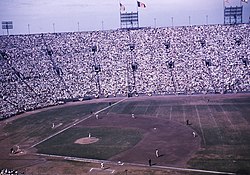
Construction on Dodger Stadium was completed in time for Opening Day 1962. With its clean, simple lines and its picturesque setting amid hills and palm trees, the ballpark quickly became an icon of the Dodgers and their new California lifestyle. O'Malley was determined that there would not be a bad seat in the house, achieving this by cantilevered grandstands that have since been widely imitated. More importantly for the team, the stadium's spacious dimensions, along with other factors, gave defense an advantage over offense and the Dodgers moved to take advantage of this by assembling a team that would excel with its pitching.
Since moving to Los Angeles, the Dodgers have won twelve more National League Championships and seven more World Series rings. The Dodgers have had only three top-five draft picks since the MLB Draft was introduced in 1965, and have had one top-ten pick (Clayton Kershaw, No. 7) since 1985.

Other historical notes
Historical records and firsts
- First baseball team to win championships in different leagues in consecutive years (1889–1890)
- First television broadcast (1939)
- First use of batting helmets (1941)
- First MLB team to employ and start an African-American player in the 20th century (Jackie Robinson, 1947)
- First MLB team to have numbers on the front of their uniforms (1952)
- First West Coast team (1958) – along with the San Francisco Giants
- First Western team to win a World Series (1959)
- First MLB team to allow a female sports journalist into a locker room (Anita Martini, 1974)
- First MLB team to establish a baseball academy in the Dominican Republic when they opened the doors to Campo Las Palmas (1987)
- Largest home-opener attendance: 78,672 (1958) (since broken by the Colorado Rockies in 1993)
- Largest single game attendance: 93,103 (1959) and 115,300 (2008) *World Record
- First MLB team to open an office in Asia (1998)
- Longest MLB record for home start going 13–0 (2009)
- North American record for the buying of a sports team ($2 billion, 2012)
- Most no-hitters (26)
- Most Cy Young award winners (12)
- First MLB team to employ a female lead trainer (Sue Falsone, 2012)
- 11,000 franchise wins Aug 30, 2020 (vs Texas)
- Most runs scored in a single inning of a postseason game (11 runs in 2020 NLCS Game 3, 2020)
- Most Rookie of the Year awards (18)
- First team to draw 3 million fans
- First team to have a pair of two-slam games in a season (2021)
- First Walk-off Grand Slam in World Series history (2024)
- Largest comeback in a clinching World Series Game (2024)
Origin of the nickname
The Dodgers' official history reports that the term "Trolley Dodgers" was attached to the Brooklyn ballclub due to the complex maze of trolley cars that weaved its way through the borough of Brooklyn.
In 1892, the city of Brooklyn (Brooklyn was an independent city until annexed by New York City in 1898) began replacing its slow-moving, horse-drawn trolley lines with the faster, more powerful electric trolley lines. Within less than three years, by the end of 1895, electric trolley accidents in Brooklyn had resulted in more than 130 deaths and maimed well over 500 people. Brooklyn's high profile, the significant number of widely reported accidents, and a trolley strike in early 1895, combined to create a strong association in the public's mind between Brooklyn and trolley dodging.
Sportswriters started using the name "Trolley Dodgers" to refer to the Brooklyn team early in the 1895 season. The name was shortened to, on occasion, the "Brooklyn Dodgers" as early as 1898.
Sportswriters in the early 20th century began referring to the Dodgers as the "Bums", in reference to the team's fans and possibly because of the "street character" nature of Jack Dawkins, the "Artful Dodger" in Charles Dickens' Oliver Twist. Newspaper cartoonist Willard Mullin used a drawing of famous clown Emmett Kelly to depict "Dem Bums": the team would later use "Weary Willie" in promotional images, and Kelly himself was a club mascot during the 1950s.
Other team names used by the franchise were the Atlantics, Grays, Grooms, Bridegrooms, Superbas, and Robins. All of these nicknames were used by fans and sportswriters to describe the team, but not in any official capacity. The team's legal name was the Brooklyn Base Ball Club. However, the Trolley Dodger nickname was used throughout this period, simultaneously with these other nicknames, by fans and sportswriters of the day. The team did not use the name in any formal sense until 1932 when the word "Dodgers" appeared on team jerseys. The "conclusive shift" came in 1933, when both home and road jerseys for the team bore the name "Dodgers".
Examples of how the many popularized names of the team were used are available from newspaper articles before 1932. A New York Times article describing a game in 1916 starts out: "Jimmy Callahan, pilot of the Pirates, did his best to wreck the hopes the Dodgers have of gaining the National League pennant", but then goes on to comment: "the only thing that saved the Superbas from being toppled from first place was that the Phillies lost one of the two games played". What is interesting about the use of these two nicknames is that most baseball statistics sites and baseball historians generally now refer to the pennant-winning 1916 Brooklyn team as the Robins. A 1918 New York Times article uses the nickname in its title: "Buccaneers Take Last From Robins", but the subtitle of the article reads: "Subdue The Superbas By 11 To 4, Making Series An Even Break".
Another example of the use of the many nicknames is found on the program issued at Ebbets Field for the 1920 World Series, which identifies the matchup in the series as "Dodgers vs. Indians" despite the fact that the Robins nickname had been in consistent use for around six years. The "Robins" nickname was derived from the name of their Hall of Fame manager, Wilbert Robinson, who led the team from 1914 to 1931.
Uniforms
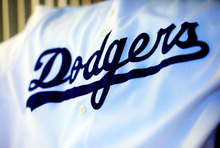
The Dodgers' uniform has remained relatively unchanged since the 1930s. The home jersey is white with "Dodgers" written in script across the chest in royal. The road jersey is gray with "Los Angeles" written in script across the chest in royal. The word "Dodgers" was first used on the front of the team's home jersey in 1933; the uniform was then white with red pinstripes and a stylized "B" on the left shoulder. The Dodgers also wore green outlined uniforms and green caps throughout the 1937 season but reverted to blue the following year.

The current design was created in 1939 and has remained the same ever since with only cosmetic changes. Originally intended for the 1951 World Series for which the ballclub failed to qualify, red numbers under the "Dodgers" script were added to the home uniform in 1952. The road jersey also has a red uniform number under the script. When the franchise moved from Brooklyn to Los Angeles, the city name on the road jersey changed, and the stylized "B" was replaced with the interlocking "LA" on the caps in 1958. In 1970, the Dodgers removed the city name from the road jerseys and had "Dodgers" on both the home and away uniforms. The city script returned to the road jerseys in 1999, and the tradition-rich Dodgers flirted with an alternate uniform for the first time since 1944 (when all-blue satin uniforms were introduced). These 1999 alternate jerseys had a royal top with the "Dodgers" script in white across the chest, and the red number on the front. These were worn with white pants and a new cap with a silver brim, a top button, and a Dodger logo. These alternates proved unpopular and the team abandoned them after only one season. In 2014, the Dodgers introduced an alternate road jersey: a gray version with the "Dodgers" script instead of the city name. Since its introduction, however, the road jersey with the "Dodgers" script was used more often than the road jersey with the "Los Angeles" script, so much that the team now considers it as a primary road uniform. In 2018, the Dodgers wore their 60th anniversary patch to honor the 60 years of being in Los Angeles.
In 2021, the Dodgers again unveiled a blue alternate uniform, this time as part of the "City Connect" series in collaboration with Nike. This uniform was similar to the blue alternates they wore in 1999, but with the script "Los Dodgers" in homage to Los Angeles' Latino community. The uniform is also worn with blue pants, and black stripes are added to the sleeves. Initially, the Dodgers wore a special blue cap with the "Los Dodgers" script but switched in 2022 to a blue interlocking "LA" cap with a black brim. The "Los Dodgers" script was then relocated to the right side. In 2023, white pants with blue piping replaced the blue pants previously worn with the "City Connect" uniform.
Midway through the 2024 season, the Dodgers unveiled their second "City Connect" uniform. The cream-based uniform paid homage to the city of Los Angeles and various chapters of the city's history that are connected to the team. The "Los Angeles" wordmark was inspired by the signage of the Dodgers' original home of Los Angeles Memorial Coliseum and was slanted upward. The number font was inspired by the mid-century typefaces that were popular during the team's early years in Los Angeles. The uniform also featured two different shades of blue: cobalt and electric, while "chili red" was based on the chest number colors the team had worn since the 1950s. The cobalt blue cap featured the "interlocking LA" and script "D" from the "Dodgers" logo merged to form the LAD team code; the said logo also appears as a sleeve patch. Above the manufacturer's tag is the hashtag #ITFDB, a reference to broadcaster Vin Scully's catchphrase "It's time for Dodger baseball!".



